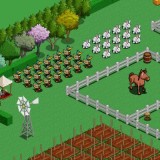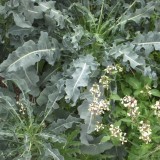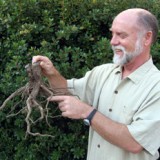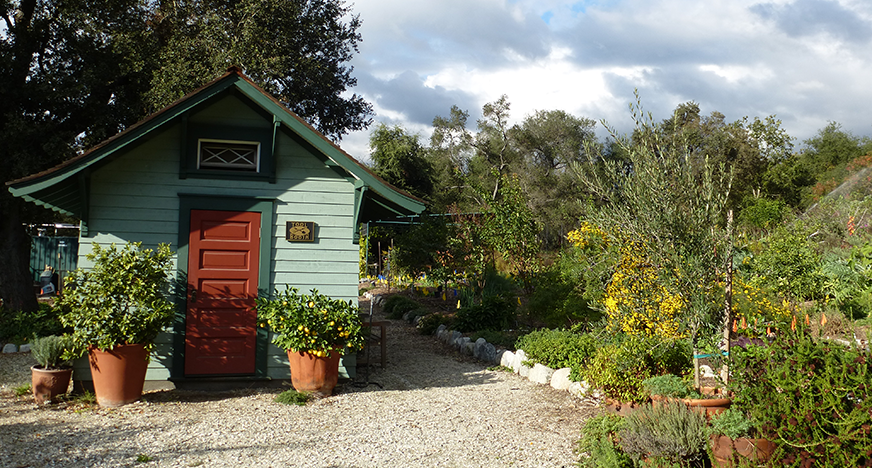 I picked up a handy tip on plant spacing from John Jeavons’ book How to Grow More Vegetables. Jeavons dislikes rows and instead uses the triangular spacing of the French biointensive method. You can view a nice diagram of biointensive spacing on the LandShare Colorado website. And see some images of the way Jeavons’ spaces his garden on This Girl’s Gone Green. Triangular plantings squeeze more veggies into small spaces. The tight spacing, with leaves allowed to just touch each other when the plant is mature, also creates a living mulch which shades the soil and saves water.
I picked up a handy tip on plant spacing from John Jeavons’ book How to Grow More Vegetables. Jeavons dislikes rows and instead uses the triangular spacing of the French biointensive method. You can view a nice diagram of biointensive spacing on the LandShare Colorado website. And see some images of the way Jeavons’ spaces his garden on This Girl’s Gone Green. Triangular plantings squeeze more veggies into small spaces. The tight spacing, with leaves allowed to just touch each other when the plant is mature, also creates a living mulch which shades the soil and saves water.
 Jeavons suggests cutting out some triangles in different sizes to assist in planting. Using scrap wood, I made triangles in 3, 4, 6, 8, 12, and 15-inch sizes, taking the spacing suggestions in Jeavons’ charts for the seeds I had planted in flats. When it came time to transplant the seedlings I used the triangles to create hexagonal blocks of tightly spaced veggies. Cutting a notch in the corners of the triangles would be a slight improvement and allow for easier planting.
Jeavons suggests cutting out some triangles in different sizes to assist in planting. Using scrap wood, I made triangles in 3, 4, 6, 8, 12, and 15-inch sizes, taking the spacing suggestions in Jeavons’ charts for the seeds I had planted in flats. When it came time to transplant the seedlings I used the triangles to create hexagonal blocks of tightly spaced veggies. Cutting a notch in the corners of the triangles would be a slight improvement and allow for easier planting.

I could end this post leaving you all to admire my pretty little seedlings planted in neat biointensive rows. But here at Homegrown Evolution we believe in telling the truth. Growing vegetables has its frustrations. The day after I planted our winter vegetable garden (we have two growing seasons here in Southern California), we had a freak October heatwave, causing a panicked run to the nursery to buy some shade cloth. This was followed by one of Mr. Homegrown’s notorious gardening meltdowns, dreaded by the very patient Mrs. Homegrown. We’ll keep our fingers crossed that I got that shade cloth up in time.






Yeah, the weather’s mood swings have been messing with my garden here in Long Beach, too.
I haven’t read John Jeavon’s book so maybe I don’t know what I’m talking about, but triangular spacing will only give you better use of space in certain shapes of plots. If you want to plant more plants in a given space, you should check out packing algorithms. Otherwise, you could be wasting a ton of space with triangular spacing that you wouldn’t have with rows. Here’s an example: http://www2.stetson.edu/~efriedma/cirinsqu/
I have been too afraid to put my seedlings into the ground for JUST this reason. They are still sheltered in their sprouting pots on my shady back patio. Rootbound vs. planting too soon? It’s a sad mental war between two fears.
You should try “Square Foot Gardening” next time. Basically the same concept, but easier than those triangles.
Mrs. Homegrown here –
I wanted to add in response to Erik’s post, as well as to a couple of comments here, that you have to do what works for you. Different systems work for different people.
Planting seedlings close together is a good general rule of thumb. Plants like being close. It shades the soil and conserves water. For this reason, rows are not the best way to grow in a home garden. Clusters are better.
I dislike rigid geometrical systems, so when I plant, I follow whims all my own, e.g. “I think this cabbage would look good circled with marigolds.”
IMO it’s easier to thin slightly over planted beds than it is to deal with big gaps. So I space my seeds/seedlings tight and thin them out as the plants grow.
This slapdash system of gardening makes me happy, and it works well enough.
Erik is all about systems, and is always searching for better systems. So this year everything is planted in triangles. Those templates really help him plan and plant his beds, so I think they’re great.
Square Foot Gardening is another methodology that people like a lot. It’s waaaaay too organized for me. Erik has tried it, though, and while he liked some aspects of it found that he couldn’t keep up with it in terms of planning. But certainly, it’s a strong, proven system for those it suits.
So, as always, what works, works.
Good gardening to you!
Thanks for the link to the biointensive spacing diagram on our site! I hope it is helpful. I have to imagine many of your readers are also checking out our online farm & garden planner (the Fantastic Farm & Garden Calculator) since it was designed with biointensive methods in mind. We use it to plan our 4000 s.f micro-farm & CSA, as well as a small personal garden. Last year we got 1 lb per s.f. (double the national average) and hope to do better this year. You can find it at http://www.landshareco.org
Best, Jim
Thanks Jim–and I hope people check out your site.
An update–the intensive planting method has worked well for me this winter season. We had lots of rapini, arugula, Swiss chard and turnips. It looks nice too.
Eric or homegrown guys, I need to know how to calcualte the biointensive spacing from normal spacing figures. can not find it anywhere on the net. do you use the recommended spacing (between plants in a row) as a base to make the triangles? I have not much experience such as Mrs homegrown, and think too close is not good. Funny due to my inexperience, I used the biointensive method. but it needs some fine tuning..
Hi Volker,
Coincidentally, I just got back from taking Jeavon’s three day biointensive workshop and will do a brief blog post about it soon. Do you have his book Grow More Vegetables? In the book he has the spacing for most common vegetables. For vegetables not included in his book I’ve used the recommended spacing (between plants in a row). But in the intensive method it’s more often slightly closer. It’s also a matter of trial and error–spacing can be different depending on your soil and light conditions. In the end you’re aiming for the leaves to just touch.
Pingback: Natural Pattern Study: Hexagons - Bean & Bee
Pingback: 10 Tips for {New} Food Gardeners |